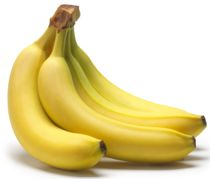Bananas

Bananas are the top selling fruit in the United States, owing in part to their sweet taste and built-in, easy-to-open packaging. As they ripen, they become sweeter as their starch turns to sugar.
Bananas are picked while still green and hard, so that they will ripen before and during transport. Left to ripen on the plant, they split open and take on a cottony texture and flavor. Even in tropical areas where bananas are cultivated, the fruit is cut from the plant while green and left to ripen after being picked.
"Fair trade" bananas are growing in popularity due to poor worker conditions on many commercial banana plantations.
| Serving size: | 1 banana (7 inches long) |
| Region: | Caribbean, tropical regions of Latin America |
Health Benefits
| Colon | Abundant in the compound, fructooligosaccharide, which feeds healthy intestinal bacteria. |
| Kidneys | Especially protective against kidney cancer in women. One study showed that eating 4-6 bananas per week can cut the risk of kidney cancer among women in half. |
| Stomach | Studies have shown that bananas help protect the stomach from ulcers by thickening the mucus lining of the stomach and destroying the bacteria that causes ulcers. |
Nutrients
| Carbohydrates | 27 g | 9% | Generally score between 30 and 60 on the glycemic index, depending on ripeness, putting them in the low- to mid-range. |
| Fiber | 3.1 g | 12% | Helps counteract some of the negative effects of their carbohydrate content. |
| Manganese | 0.3 mg | 10% | |
| Potassium | 422 mg | 12% | |
| Vitamin B6 | 0.4 mg | 22% |
